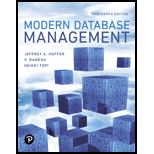
Define each of the following terms:
- dynamic view
- correlated subquery
- materialized view
- base table
- Join
- equi-join
- self join
- outer join
- virtualized table
(a)
Define Dynamic View.
Explanation of Solution
Dynamic view is not a temporary table and its definition is stored in the system catalog. The content of this view is materialized as a result of an SQL query that uses the view.
(b)
Define Correlated Subquery.
Explanation of Solution
In SQL, Correlated subquery is a subquery that processes the inner query depending on the data from the outer query.
(c)
Define Materialized View.
Explanation of Solution
Materialized view is different from the dynamic view. It is stored on a disk and is refreshed when used or at some intervals. Copies of data is created in the same way as dynamic view.
(d)
Define Base Table.
Explanation of Solution
Base Table is a table from relational data model that contains the inserted raw data. These tables are correspond to those relations which are identified in the conceptual schema of database.
(e)
Define Join.
Explanation of Solution
Join is a relational operation that is used to combine two tables with a common domain into a single view or table.
(f)
Define Equi Join.
Explanation of Solution
Equi-join is a form of join in which the joining is performed on the basis of the equality between values in the columns that are common. Those common columns appear in the result table redundantly.
(g)
Define Self Join.
Explanation of Solution
Sometimes a join requires match of rows in a table with other rows in that same table which means joining of table with itself. This is known as self join.
(h)
Define Outer Join.
Explanation of Solution
Outer join is a form of join in which those rows are not included in the resulting table that do not have similar values in the common columns.
(i)
Define Virtualized Table.
Explanation of Solution
Virtualized tables are not maintained as the tables with real data. These are constructed automatically as the requirement of a DBMS.
Want to see more full solutions like this?
Chapter 6 Solutions
Modern Database Management
Additional Engineering Textbook Solutions
Computer Science: An Overview (13th Edition) (What's New in Computer Science)
Database Concepts (8th Edition)
Introduction To Programming Using Visual Basic (11th Edition)
Starting Out with C++ from Control Structures to Objects (9th Edition)
SURVEY OF OPERATING SYSTEMS
Concepts Of Programming Languages
- Considering the TM example of binary sum ( see attached)do the step-by-step of execution for the binary numbers 1101 and 11. Feel free to use the Formal Language Editor Tool to execute it; Write it down the current state of the tape (including the head position) and indicate the current state of the TM at each step.arrow_forwardI need help on inculding additonal code where I can can do the opposite code of MatLab, where the function of t that I enter becomes the result of F(t), in other words, turning the time-domain f(t) into the frequency-domain function F(s):arrow_forwardI need help with the TM computation step-by-step execution for the binary numbers 1101 and 11. Formal Language Editor Tool can be used to execute it; Write it down the current state of the tape (including the head position) and indicate the current state of the TM at each step;arrow_forward

 Database Systems: Design, Implementation, & Manag...Computer ScienceISBN:9781305627482Author:Carlos Coronel, Steven MorrisPublisher:Cengage Learning
Database Systems: Design, Implementation, & Manag...Computer ScienceISBN:9781305627482Author:Carlos Coronel, Steven MorrisPublisher:Cengage Learning Database Systems: Design, Implementation, & Manag...Computer ScienceISBN:9781285196145Author:Steven, Steven Morris, Carlos Coronel, Carlos, Coronel, Carlos; Morris, Carlos Coronel and Steven Morris, Carlos Coronel; Steven Morris, Steven Morris; Carlos CoronelPublisher:Cengage Learning
Database Systems: Design, Implementation, & Manag...Computer ScienceISBN:9781285196145Author:Steven, Steven Morris, Carlos Coronel, Carlos, Coronel, Carlos; Morris, Carlos Coronel and Steven Morris, Carlos Coronel; Steven Morris, Steven Morris; Carlos CoronelPublisher:Cengage Learning A Guide to SQLComputer ScienceISBN:9781111527273Author:Philip J. PrattPublisher:Course Technology Ptr
A Guide to SQLComputer ScienceISBN:9781111527273Author:Philip J. PrattPublisher:Course Technology Ptr Programming with Microsoft Visual Basic 2017Computer ScienceISBN:9781337102124Author:Diane ZakPublisher:Cengage Learning
Programming with Microsoft Visual Basic 2017Computer ScienceISBN:9781337102124Author:Diane ZakPublisher:Cengage Learning





